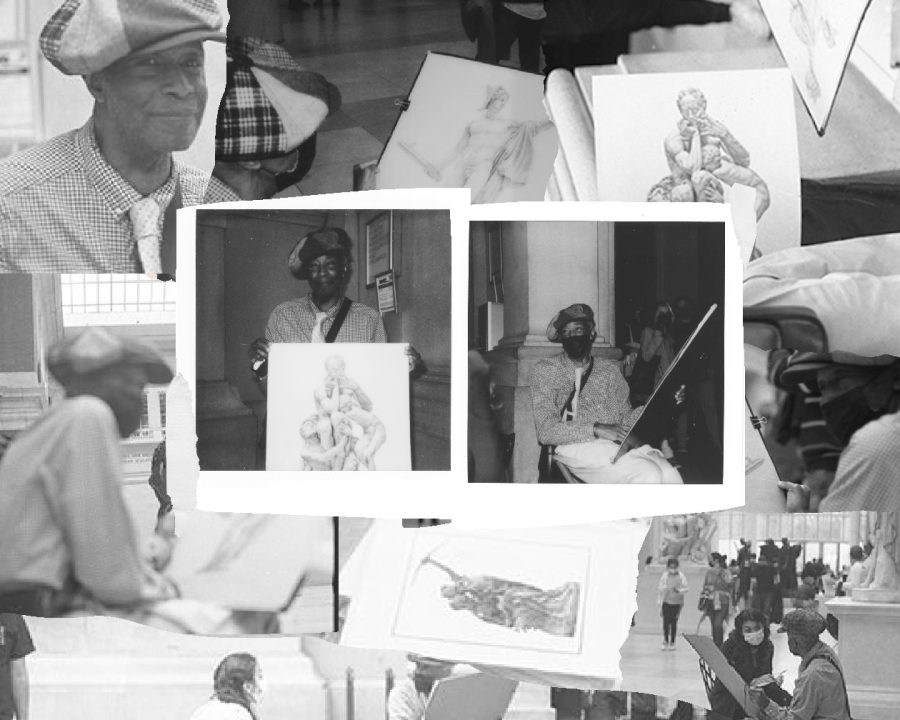Man of the Met
May 3, 2022
Walk straight until you reach the looming Medieval Iron Gates, then turn left, past the antique furniture and porcelain pottery, until you enter the room with glass ceilings and sculptures chiseled from stone. That’s where the staff directed me when asked where the man who sketches sits. In a large hat that folds over the edges of his head, hunched over a Strathmore Artagain 400 Series drawing pad half his height, you will find Dwight Deworgé.
Now 72 years old, Deworgé has been a regular at The Met for the past 27 years coming every day (except Wednesdays when they’re closed) to render sculptures sprinkled throughout the museum. Deworgé explained the difference between a sketch, a rough drawing not intended to be finished and a rendering, a much more detailed realistic illustration, which is Deworgé’s main medium, upon meeting him.
Deworgé began attending the Met regularly around 1995 after being asked if his art was for sale by an elderly gentleman peeking over his shoulder as he rendered. He has resided at the museum attempting to sell his work since.
Other than commissions, sculptures are the main subject of Deworgé’s renderings as he feels they are, “the highest form of art” and says his renderings are “a homage to the masters who carved these pieces so magnificently.”
Born in Chattanooga, Tennessee, Deworgé decided to move to New York City in 1984 to follow his dreams as an artist and currently resides in Bushwick, Brooklyn with two roommates. Deworgé commutes from Bushwick to Uptown Manhattan where The Met is located, making his daily commute around 90 minutes. He takes three subways and then a bus from the west side as he cannot carry his materials for the duration of the 11-minute walk from the 4/5 train, which would cut his commute by thirty minutes. Deworgé attends The Met from 2 p.m. to 5 p.m. as that is when lighting is best.
Deworgé’s rent is paid through social security and groceries are bought with food stamps. His art is his only form of income, selling his renderings for the number of hours spent to complete them multiplied by minimum wage, and his notecards for ten dollars. Both can be purchased in person at The Met or on his website www.manofthemet.com where there is also a portal to request rendering commissions. His sculpture renderings can take between one to eight months depending on how inspired he is, but on average, they’re completed in two to three months.
Before moving to NYC, Deworgé responded to an ad he found looking for a tenant to stay in a three thousand dollar apartment. He called, gleefully explaining he can afford the rent, but upon expressing his surprise for asking for annual rent upfront, the woman on the phone explained the three thousand dollars was a monthly expense. Deworgé exclaimed “Are you crazy?!” and was immediately hung up on.
Despite living as a New York City resident for nearly forty years, Deworgé has only had the opportunity to attend three museums—Brooklyn Museum, The Frick Collection and The Met—as he cannot afford to attend private museums.
Deworgé’s greatest wish as an artist is to leave behind a legacy and provide cultural enrichment for generations to come. It is because of this that Deworgé has chosen to practice realism in his work. He feels realism is an art form that is easier to understand cross-culturally, making his work accessible to a broader audience.
When asked if he had advice to give to young passionate artists, Deworgé shared, “I have realized through the many years of doing this, it also goes back to following your heart no matter the profession.”
Deworgé continued, “Have in your heart the three ‘P’ traits. Whatever it is you’re going to do, spend the time doing it—practice. Patience—that’s the second ‘P’—keep working at it until you get it right. The third one, which I think is the most important trait at all as you cannot complete the other two without this, you won’t be able to stick with it and you won’t put in the time—passion. You have to love doing it.”
Deworgé agreed to participate in this interview in hopes it would inspire readers to support his work. Whether you’re a college student only able to purchase notecards, or a bigger buyer willing to purchase one of his renderings, anything helps.
Currently, you can find Deworgé in the European Sculpture and Decorative Arts collection rendering “Perseus with the Head of Medusa.”













Rose Anne • May 2, 2024 at 12:33 pm
Such a great artist following his God-given talent. I met him in April 2024 on my way to Italy. My husband had passed away nearly a year ago and his last wish was that I go Back to Florence Italy. He was an artist and we loved our many visits there.
I had a long conversation with Deworg— which made my day. He is a trained and gifted artist, and my husband would have been proud to meet him. Bless the Met for giving This lovely man, a chance to draw, to earn a bit of money, and to spread his smile and talent to visitors from all over the world. Rose Anne
Gina Guido • May 11, 2022 at 3:12 pm
Great piece! Makes me want to travel to the Met from Long Island to purchase a piece of artwork from this artist. The dedication and passion that he has for his artwork is admirable and inspiring. Thank you for highlighting one of the many gems that New York has hidden in it’s big city. There are so many wonderful artists that get overlooked in our city. It just reminds me to open my eyes, stop rushing and be present. Thank god we have people like this talented editor, Gia Sapracino, to point out one of the many big treasures our city is lucky to call their own.
Rita Sparo • May 10, 2022 at 7:33 pm
The writer Gia makes you want to visit Deworge, look over his work. Maybe make a purchase or two to add to our to memorabilia. Deworge is living in the same area that I ran away from. Very different back then. Gia thanks for presenting him to us.